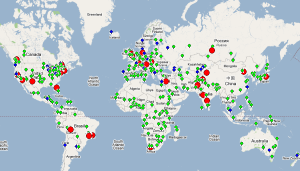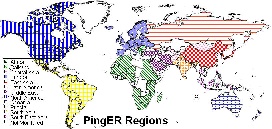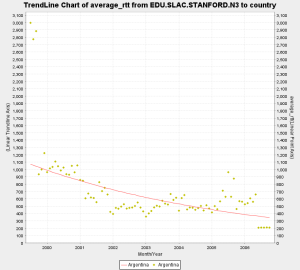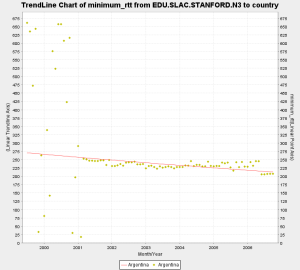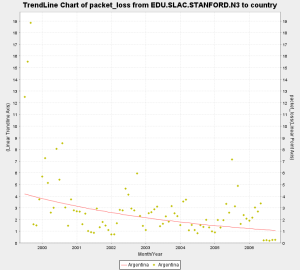...
The sites from which there is PingER monitoring are shown in red below, sites which are monitored by all monitoring hosts (these are referred to as beacon sites and also include monitor sites) are shown in blue, and other monitored remote sites are shown in green. From SLAC PingER monitors about 460 sites, CERN used to monitor about 132 sites, however after re-installing in December 2006) they now only monitor beacon sites (56). ICTP Trieste monitors 105 sites but only has data going back to September 2006. To the right of the PingER map we also show a map which defines how we are assigning countries to regions.
Latin America includes South America, Caribbean and Mexico. We have three monitoring hosts in Brazil (two in Sao Polo and one in Rio De Janeiro) and one monitoring host in Bolivia.The map below shows the location of the sites.
...
| Include Page | ||||
|---|---|---|---|---|
|
...
Argentina
In December 2001, Argentina's (RETINA) connected to AMPATH, so the increase in performance to Argentina can be seen from SLAC. Around June 2006 the TCP throughput of Argentina increased significantly. The average RTT reduced from 600 ms to 200 ms. The minimum RTT reduced from 250 ms to 200 ms.The packet loss has also decreased significently.
...
Brazil to Brazil: Direct
Brazil to Ecuador: Brazil -> Spain(Madrid) -> Ecuador OR Brazil -> US (Kansas) -> Ecuador
Brazil to Cuba: Brazil -> US(Miami) -> (Satellite Provider) -> Cuba
Brazil to Venezuela: Brazil -> Europe -> Venezuela OR Brazil -> US -> Venezuela OR Brazil -> Spain(Madrid)-> Venezuela
Brazil to Costa Rica: Brazil -> US -> Costa Rica
Brazil to Argentina: Brazil -> US -> Uruguay -> Argentina
Brazil to Mexico: Brazil -> US(California) -> Mexico
Brazil to Chile: Brazil -> US -> Uruguay -> Chile
Brazil to Uruguay: Brazil -> US (California) -> Uruguay
Brazil to Bolivia: Brazil -> US (Kansas) -> Italy (Rome) -> Bolivia
Brazil to Paraguay: Brazil -> Spain (Madrid) -> Paraguay
Brazil to Honduras: Brazil -> US(Kansas) -> Guatemala -> Honduras
Brazil to Peru: Brazil -> US(California) -> Uruguay -> Peru
Brazil to Colombia: Brazil -> US (Kansas) -> Colombia
Brazil to Guatemala: Brazil -> US -> Gutemala
Brazil to El Salvador: Brazil -> Spain (Madrid) -> El Salvador
Brazil to Panama: Brazil -> US -> Italy(Rome) -> Panama
ALICE and RedCLARA
Since its launch in September 2004, the ALICE project has been a key component in reducing disparities within Latin America by bridging the "Digital Divide" both within the region and with the rest of the world. The project has enabeled Latin American researchers to become key players in the global research community.
On September 1 of 2004, RedCLARA began to provide direct connectivity with 155 Mbps, in "a ring" topology, linking the NRENs of Argentina, Brazil, Chile, Panama and Mexico, and connecting them to GÉANT at 622 Mbps throughout a connection between São Paulo, Brazil, and Madrid, Spain.RedCLARA now connects 14 countries across Central and South America, allowing 738 universities and research institutes to communicate with their European and global peers directly.
The performance of Research and Educational Networks of Argentina, Brazil, Chile, Mexico, Guatemala and Uruguay has significantly improved due to ALICE project. In December 2001, Argentina's (RETINA) connected to AMPATH, so the increase in performance to Argentina can be seen from US. Around June 2006 the TCP throughput of Argentina increased significantly. The average RTT reduced from 600 ms to 200 ms. The minimum RTT reduced from 250 ms to 200 ms. The packet loss has also decreased significantly. From January 2001 - July 2001 the loss from US to Brazil decreased from 8 % to 1 %. The Average RTT decreased from 375 ms to 200 ms. The TCP throughput improved but it have not stabilized (still lots of variations). In June 2001, Chile's REUNA becomes the first Latin American NREN (National Research and Educational Network) to get connected to the AMPATH POP in Miami. As a result the TCP throughput increased significantly. Minimum RTT reduced from 230 ms to 200 ms and average RTT reduced from 725 ms to 250ms. Packet loss reduced from 10 % to 1 %. In July 2003 Mexico's connectivity improved. Minimum RTT became stable from 100 ms to 60 ms and average RTT also became stable. Since Uruguay joined in June, 2005 its TCP throughput has improved. Average RTT reduced from about 325 ms to 225 ms. Minimum RTT reduced from about 270 ms to 220 ms The loss situation has not seen much improvement.
In the beginning of 2006 Paraguay moved from satellite to fiber but Cuba is still connected through satellite. Average and min RTT of Cuba are greater than 800ms and the packet loss is around 2-4 % which is dreadful. RedClara is also planning for a connection to Cuba in the near future, so that it can also play role in global research initiatives.
Minimum RTT and Packet Loss from US to Latin American Countries
...
